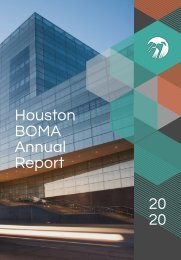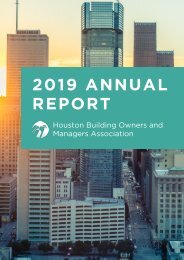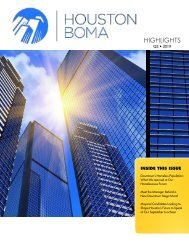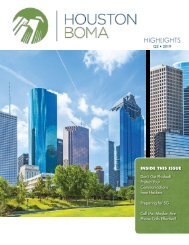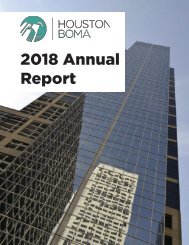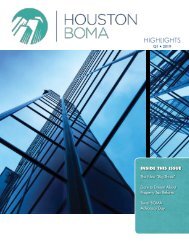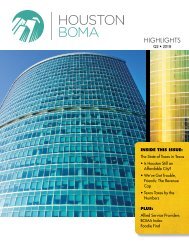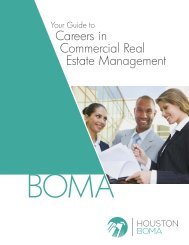Houston BOMA Highlights Q2 2020
- No tags were found...
You also want an ePaper? Increase the reach of your titles
YUMPU automatically turns print PDFs into web optimized ePapers that Google loves.
Feature<br />
Preparing for Resuming Operations in a New Normal:<br />
Things to Consider for Building Re-Entry<br />
When it comes to COVID-19 and tenant re-entry, any mitigation actions you can take now will be money and time well spent,<br />
according to experts participating in <strong>BOMA</strong>’s recent COVID-19 webinars. There are several things you can do right now to facilitate<br />
tenant re-entry and the return to business. View <strong>BOMA</strong> International’s guide here for more information.<br />
Know your documents.<br />
If you haven’t done so already, review existing leases, contracts and insurance policies for risks, protections and notice requirements.<br />
Consult with your legal team on potential issues, including force majeure, rent abatement, and other lease-related<br />
concerns, so you can be prepared should they arise.<br />
If you’re not sure where to<br />
start planning, build a<br />
reverse timeline.<br />
Anticipate shortages in supply.<br />
Ordinary things like toilet paper, soap and sanitizer have become hot<br />
commodities. You may be well-stocked now, but what happens if supply<br />
chain disruptions are long-term? Get in touch with your vendors, suppliers<br />
and contractors to ask how they plan to be available to you during recovery.<br />
When planning on restocking supply, anticipate bottlenecks and possible<br />
shortages or delays.<br />
Serving your<br />
community for<br />
all restoration<br />
and disaster<br />
planning needs.<br />
Create an employee re-entry plan.<br />
As the spread of the virus slows and state governments begin allowing employees to go back to work, each company’s leadership<br />
will need to determine how to proceed with re-entry. To ensure a smooth transition back to the office, communicate with<br />
your employees about what they can expect. Will there be new workspace configurations, social distancing practices, employee<br />
screening, or scheduling changes? Then, help minimize disruption for your employees by consulting your IT provider about what<br />
you need to do to get everyone reconnected to your network. Finally, consider your office’s shared resources and common areas.<br />
Did anyone empty the refrigerator?<br />
Outline and communicate a tenant re-occupancy plan.<br />
Keep in mind it’s much easier for tenants to leave your office building than to return. Communication with your tenants is key.<br />
You’ll want to ensure their individual systems are being properly maintained, and they will need to know what kind of environment<br />
and procedures to expect in your building. Are your common areas limited or closed? Do you plan to allow fewer people to<br />
utilize an elevator at one time, and how will you deal with lines to use the elevator? All of the equipment that left your building<br />
now has to come back in. Do you have a plan to accommodate all the people and equipment coming back into the building?<br />
Consider what you need to do to get your building physically ready before tenants arrive. Have you ensured the water supply<br />
is safe for tenant use? You may want to flush building water systems before re-opening. Disinfection of premise plumbing may<br />
be needed, and water testing (for potability) may also be necessary to either validate efficacy of remedial processes or determine<br />
if remediation is needed to restore building water system conditions. You may also think about implementing new operational<br />
changes, like maximizing outdoor air supply of HVAC system where possible and extending operational periods up to 24/7, with<br />
building purges at night.<br />
If you’re not sure where to start planning, build a reverse timeline. Start with your re-entry date, and work backwards to<br />
determine what must be done when.<br />
These are just a few of things you’ll need to think about when planning for re-entry. Ask, “What must go right?” and “What<br />
could go wrong?” to help guide your decision-making process and mitigate risk. With the right precautions, we’ll soon be able<br />
to return to our buildings and find a new normal. n<br />
Storm Damage<br />
Hurricane Preparedness<br />
Mold Remediation<br />
Hail & Wind Damage<br />
888-293-9953 mooringusa.com<br />
page 12<br />
<strong>Houston</strong> Building Owners & Managers Association <strong>Q2</strong> • <strong>2020</strong><br />
<strong>Houston</strong> Building Owners & Managers Association <strong>Q2</strong> • <strong>2020</strong><br />
page 13




